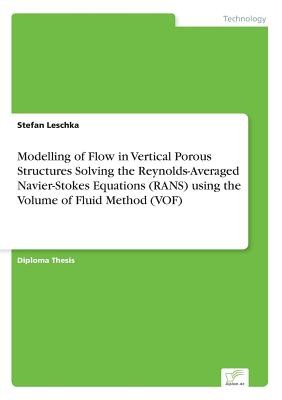
- We will send in 10–14 business days.
- Author: Stefan Leschka
- Publisher: Diplom.de
- Year: 2002
- Pages: 106
- ISBN-10: 3838654692
- ISBN-13: 9783838654690
- Format: 14.8 x 21 x 0.6 cm, softcover
- Language: English
- SAVE -10% with code: EXTRA
Modelling of Flow in Vertical Porous Structures Solving the Reynolds-Averaged Navier-Stokes Equations (RANS) using the Volume of Fluid Method (VOF) (e-book) (used book) | bookbook.eu
Reviews
Description
Inhaltsangabe: Abstract: In this thesis the simulation of the flow in alpha vertical permeable structure with alpha free surface is described. The underlying physical data had been achieved from experiments in a wave flume at the University of Cantabria. For the calibration of the numerical model COBRAS, a VOF type programme developed at Cornell University, the numerical results are compared with the laboratory data. The data analysed comes from 8 free surface sensors, placed inside and outside of the porous structure, and 4 pressure sensors, placed on the impermeable back wall inside the porous structure. An error analysis, using the least square technique, lead to a stepwise improvement of the numerical and the porous media parameters. In this process various grids had been tested, concerning sponge layer length, source function position and cell size. Later the porous media parameter for laminar and turbulent flow had been adjusted. For various wave conditions and porous structure characteristics, the optimal values for these parameters turned out to lay between 0 and 200 for alpha and between 0.45 and 0.8 for beta. The following error analysis yielded to alpha=100 and beta=0.5 usable for all tested wave and porous media characteristics. Inhaltsverzeichnis: Table of Contents: 1.Introduction1 1.1General Introduction1 1.2Aims of study3 1.3Contents3 2.Numerical Modelling5 2.1Introduction5 2.2Overview of Numerical Models for Wave prediction6 2.3Numerical Models for Simulation of Flow in porous media7 2.3.1Overview of mathematical solutions7 2.3.2Available numerical models for porous media flow8 2.4The COBRAS Model9 2.4.1Overview9 2.4.2Governing Equations for the Mean Flow9 2.4.2.1Flow Motion Formulation9 2.4.2.1.1Navier-Stokes Equations and Boundary Conditions9 2.4.2.1.2Reynolds Equations and Boundary Conditions12 2.4.2.2Turbulence Transport Model14 2.4.2.2.1Transport Equation for Turbulent Kinetic Energy, k14 2.4.2.2.2The Transport Equation
EXTRA 10 % discount with code: EXTRA
The promotion ends in 19d.18:08:43
The discount code is valid when purchasing from 10 €. Discounts do not stack.
- Author: Stefan Leschka
- Publisher: Diplom.de
- Year: 2002
- Pages: 106
- ISBN-10: 3838654692
- ISBN-13: 9783838654690
- Format: 14.8 x 21 x 0.6 cm, softcover
- Language: English English
Inhaltsangabe: Abstract: In this thesis the simulation of the flow in alpha vertical permeable structure with alpha free surface is described. The underlying physical data had been achieved from experiments in a wave flume at the University of Cantabria. For the calibration of the numerical model COBRAS, a VOF type programme developed at Cornell University, the numerical results are compared with the laboratory data. The data analysed comes from 8 free surface sensors, placed inside and outside of the porous structure, and 4 pressure sensors, placed on the impermeable back wall inside the porous structure. An error analysis, using the least square technique, lead to a stepwise improvement of the numerical and the porous media parameters. In this process various grids had been tested, concerning sponge layer length, source function position and cell size. Later the porous media parameter for laminar and turbulent flow had been adjusted. For various wave conditions and porous structure characteristics, the optimal values for these parameters turned out to lay between 0 and 200 for alpha and between 0.45 and 0.8 for beta. The following error analysis yielded to alpha=100 and beta=0.5 usable for all tested wave and porous media characteristics. Inhaltsverzeichnis: Table of Contents: 1.Introduction1 1.1General Introduction1 1.2Aims of study3 1.3Contents3 2.Numerical Modelling5 2.1Introduction5 2.2Overview of Numerical Models for Wave prediction6 2.3Numerical Models for Simulation of Flow in porous media7 2.3.1Overview of mathematical solutions7 2.3.2Available numerical models for porous media flow8 2.4The COBRAS Model9 2.4.1Overview9 2.4.2Governing Equations for the Mean Flow9 2.4.2.1Flow Motion Formulation9 2.4.2.1.1Navier-Stokes Equations and Boundary Conditions9 2.4.2.1.2Reynolds Equations and Boundary Conditions12 2.4.2.2Turbulence Transport Model14 2.4.2.2.1Transport Equation for Turbulent Kinetic Energy, k14 2.4.2.2.2The Transport Equation


Reviews